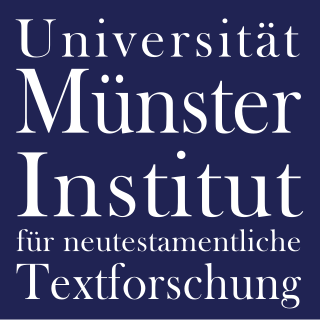Description
The original codex contained lessons from the Gospels (Evangelistarium), on 136 parchment leaves, with some lacunae. The leaves are measured (16.5 cm by 13.5 cm). [1] The first 54 other leaves were lost. The additional lessons about the season of Epiphany were inserted by other hand. [2]

Gospel originally meant the Christian message itself, but in the 2nd century it came to be used for the books in which the message was set out. The four canonical gospels — Matthew, Mark, Luke and John — were probably written between AD 66 and 110, building on older sources and traditions, and each gospel has its own distinctive understanding of Jesus and his divine role. All four are anonymous, and it is almost certain that none were written by an eyewitness. They are the main source of information on the life of Jesus as searched for in the quest for the historical Jesus. Modern scholars are cautious of relying on them unquestioningly, but critical study attempts to distinguish the original ideas of Jesus from those of the later authors. Many non-canonical gospels were also written, all later than the four, and all, like them, advocating the particular theological views of their authors.

A lacuna is a gap in a manuscript, inscription, text, painting, or a musical work. A manuscript, text, or section suffering from gaps is said to be "lacunose" or "lacunulose". Some books intentionally add lacunas to be filled in by the owner, often as a game or to encourage children to create their own stories.
The text is written in Greek minuscule letters, in one column per page, 16-18 lines per page. [3] [4]
It contains music notes. [2]
This page is based on this
Wikipedia article Text is available under the
CC BY-SA 4.0 license; additional terms may apply.
Images, videos and audio are available under their respective licenses.
Lectionary 283, designated by siglum ℓ 283 is a Greek manuscript of the New Testament, on parchment. Palaeographically it has been assigned to the 11th century.
Scrivener labelled it as 162e.
Lectionary 280, designated by siglum ℓ 280 is a Greek manuscript of the New Testament, on parchment. Palaeographically it has been assigned to the 14th century.
Scrivener labelled it as 185e.
Lectionary 281, designated by siglum ℓ 281 is a Greek manuscript of the New Testament, on parchment. Palaeographically it has been assigned to the 14th century.
Scrivener labelled it as 160e.
Lectionary 282, designated by siglum ℓ 282 is a Greek manuscript of the New Testament, on parchment. Palaeographically it has been assigned to the 14th century.
Scrivener labelled it as 161e.
Lectionary 284, designated by siglum ℓ 284 is a Greek manuscript of the New Testament, on parchment. Palaeographically it has been assigned to the 10th century.
Scrivener labelled it as 163e.
Lectionary 285, designated by siglum ℓ 285 is a Greek manuscript of the New Testament, on parchment. Palaeographically it has been assigned to the 12th century.
Frederick Henry Ambrose Scrivener labelled it as 164e and 165e.
Lectionary 286, designated by siglum ℓ 286 is a Greek manuscript of the New Testament, on parchment. Palaeographically it has been assigned to the 9th century.
Scrivener labelled it as 480e.
Lectionary 287, designated by siglum ℓ 287 is a Greek manuscript of the New Testament, on parchment. Palaeographically it has been assigned to the 13th century.
Frederick Henry Ambrose Scrivener labelled it as 166e.
Lectionary 288, designated by siglum ℓ 288 is a Greek manuscript of the New Testament, on parchment. Palaeographically it has been assigned to the 13th century.
Scrivener labelled it as 167e.
Lectionary 289, designated by siglum ℓ 289 is a Greek manuscript of the New Testament, on parchment. Palaeographically it has been assigned to the 14th century.
Frederick Henry Ambrose Scrivener labelled it as 168e.
Lectionary 291, designated by siglum ℓ 291 is a Greek manuscript of the New Testament, on parchment. Palaeographically it has been assigned to the 11th century.
Scrivener labelled it as 187e.
Codex Tischendorfianus V or Lectionary 293 (Gregory-Aland), designated by siglum ℓ 293 is a Greek manuscript of the New Testament, on parchment. Palaeographically it has been assigned to the 8th century.
Scrivener labelled it as 190e.

Lectionary 296 (Gregory-Aland), designated by siglum ℓ 296 is a Greek manuscript of the New Testament, on parchment. Palaeographically it has been assigned to the 10th century. The manuscript is very lacunose.
Lectionary 301 (Gregory-Aland), designated by siglum ℓ 301 is a Greek manuscript of the New Testament, on parchment. Palaeographically it has been assigned to the 13th century. The manuscript is lacunose.
Lectionary 304 (Gregory-Aland), designated by siglum ℓ 304 is a Greek manuscript of the New Testament, on paper. Palaeographically it has been assigned to the 14th century. The manuscript is lacunose.
Lectionary 305 (Gregory-Aland), designated by siglum ℓ 305 is a Greek manuscript of the New Testament, on parchment. Palaeographically it has been assigned to the 12th century. The manuscript is lacunose.
Lectionary 307 (Gregory-Aland), designated by siglum ℓ 307 is a Greek manuscript of the New Testament, on parchment. Palaeographically it has been assigned to the 12th century. The manuscript is lacunose.
Lectionary 308 (Gregory-Aland), designated by siglum ℓ 308 is a Greek manuscript of the New Testament, on parchment. Palaeographically it has been assigned to the 11th century. The manuscript is lacunose.
Lectionary 309 (Gregory-Aland), designated by siglum ℓ 309 is a Greek manuscript of the New Testament, on parchment. Palaeographically it has been assigned to the 10th century. The manuscript is lacunose.
Lectionary 330 (Gregory-Aland), designated by siglum ℓ 330 is a Greek manuscript of the New Testament, on parchment. Palaeographically it has been assigned to the 12th century. The manuscript has not survived in complete condition.







